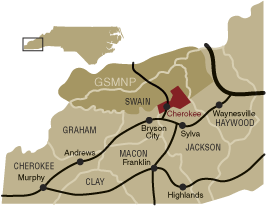 |
| Qualla Boundary is shown in red, adjoining the Great Smoky Mountains National Park |
"In partnership with the nonprofit Dogwood Health Trust, a nonprofit health organization based in Asheville, we began providing access to free community-wide testing (even asymptomatic) long before North Carolina recommended it," Clapsaddle reports. "We set up roadblocks and allowed only residents or EBCI enrolled members to access the Boundary. We closed non-essential businesses, including Harrah’s Cherokee Casino and our government offices. We employed a sophisticated and comprehensive contact tracing system that has been credited with identifying asymptomatic carriers before they unknowingly transmitted the virus."
But even as they fought the pandemic, the tribe saw an "explosion" of drug-overdose deaths, and even more overdoses that didn't result in death. Tribal aid ensured that the community was cared for, "but it also meant that we became one of the few communities in far western North Carolina who still had the means to be paying customers — especially in the illegal drug trade," Clapsaddle reports.
Because of the pandemic blockades, drug runners tried to make the same money with fewer trips, Clapsaddle reports. So they brought in a concentrated form of fentanyl-laced heroin that street dealers could later cut before selling to customers. But fentanyl is deadly in tiny doses, and the new product was stronger even after the dealers cut it. That resulted in seven deaths.
That highlighted for tribal leaders the lack of consistent data on overdoses and drug use, Clapsaddle reports. Emergency care providers and health-care facilities often don't code a death as an overdose, fearing it might bring stigma. Instead, they sometimes code such deaths as heart attacks.
"The EBCI’s Overdose Map, where the collected data is housed for analysis, also does not account for instances when Narcan, an overdose-reversing medication, was used," Clapsaddle reports. EBCI Secretary of Health and Human Services Vickie Bradley said she's trying to improve data collection.
The biggest takeaway from the pandemic, Clapsaddle writes, is that "To date, state and federal aid has done little to assist impoverished Native communities coping with historical grief and trauma in their fight against substance abuse. But if we are to learn anything from covid-19, it is that waiting for outside help is a death sentence."
No comments:
Post a Comment